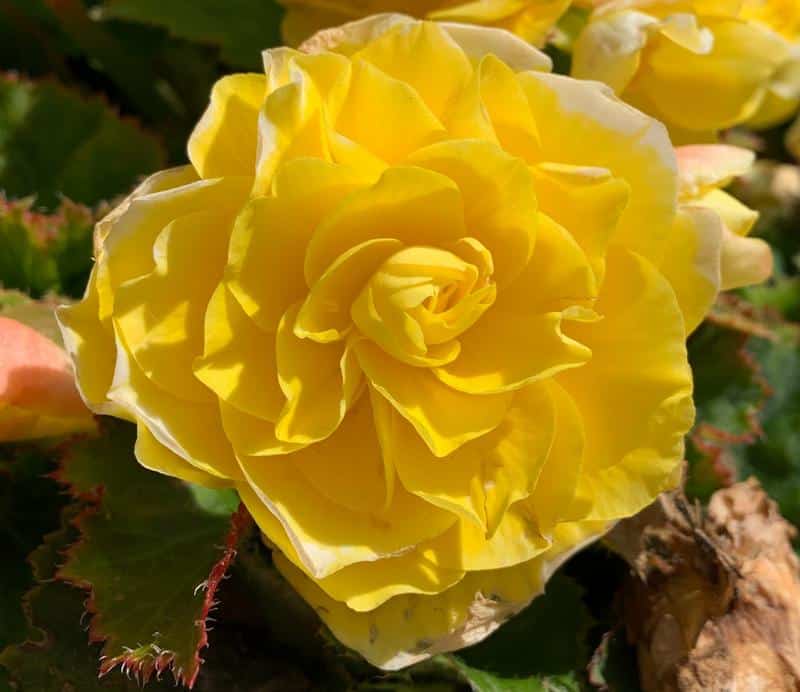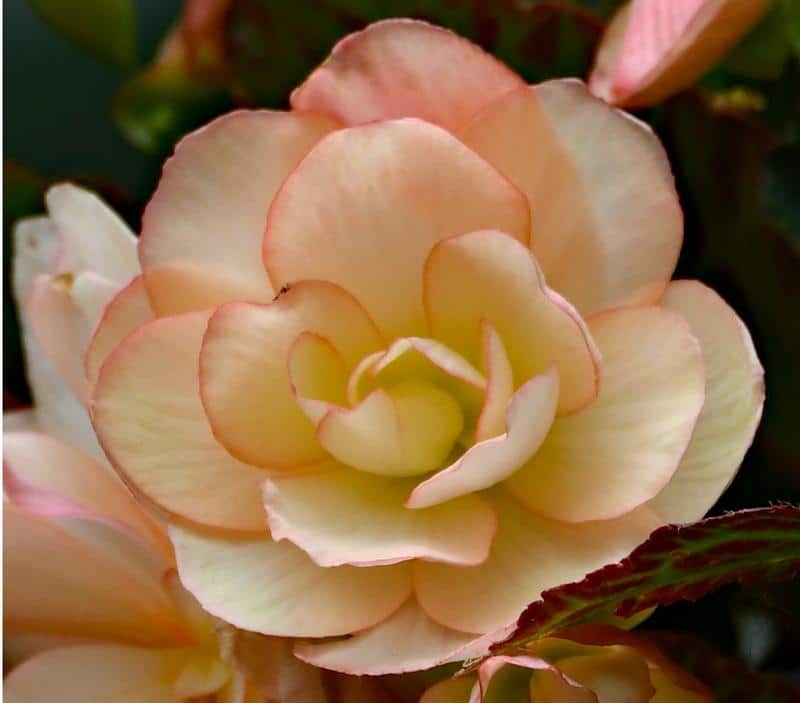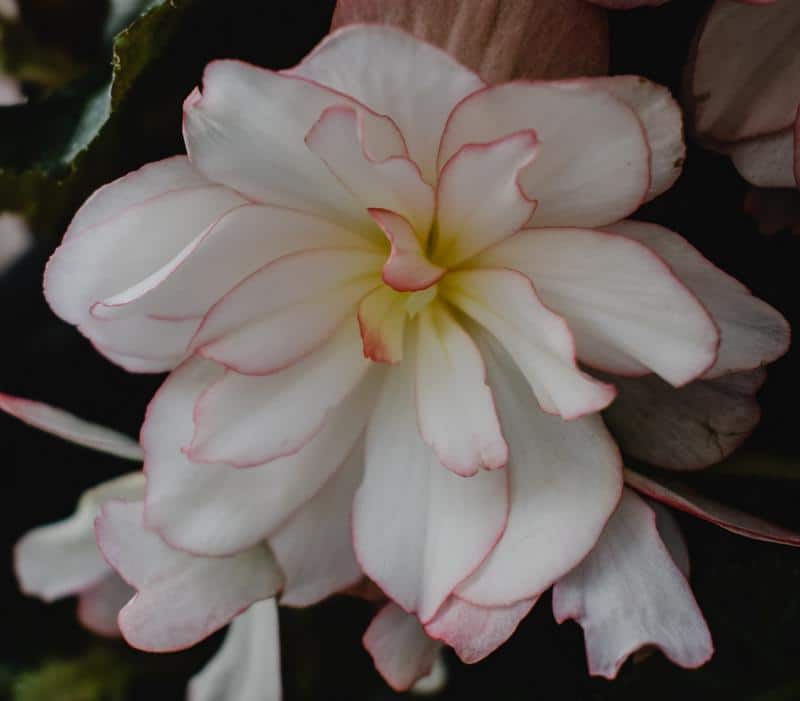Are Begonias Toxic to Dogs? Are Begonias Poisonous to Dogs?
Are begonias toxic to dogs? Are begonias poisonous to dogs? If so, which types (angel wing, rex, tuberous, or rieger)? In this article, we’ll teach you everything you need to know about if begonias are toxic to dogs, including what to do if they’ve already eaten some. We’ll then teach you the two commands that will ensure your dog always stays safe around begonias from now on.
Next, we’re going to cover other things important you should know about begonias and dogs, such as how to keep dogs away from begonias so they can grow bright and beautiful. Finally, we’ll wrap up by instructing you on how to grow begonias in pots. Keep reading!
Are Begonias Toxic to Dogs?

Begonias are toxic to dogs. The plant contains insoluble oxalates which, if ingested, can lead to symptoms such as oral irritation, excessive drooling, vomiting, difficulty swallowing, and kidney failure in severe cases. Therefore, it’s important to prevent dogs from having access to these plants.
Are Begonias Safe for Dogs?
Begonias are not safe for dogs to eat or chew. The Begonia species contains insoluble oxalates, compounds that can cause irritation to a dog’s mouth and gastrointestinal tract if ingested. The highest concentration of these oxalates is found in the plant’s tubers, making them especially dangerous.
Teaching the “Leave It” Command
Training your dog with the “Leave It” command is very helpful in keeping them away from Begonias. Here’s how to do it:
- Start with a treat in both hands. Close your fist over one treat and present it to your dog while saying “leave it.”
- Wait for your dog to stop trying to get the treat. This might involve licking, pawing, or barking. As soon as they stop, give them the treat from your other hand.
- Repeat this process until your dog moves away from the first treat when you give the command. Remember to reward them with the second treat.
This command is beneficial for ensuring that your dog understands that they should not touch, and more importantly, not eat the Begonia plant.
Teaching the “Drop It” Command
The “Drop It” command can be important if your dog already has a piece of Begonia in their mouth. Here’s how to teach it:
- Offer a low-value toy to your dog. When they take it in their mouth, say “drop it” while showing them a high-value treat.
- They will drop the toy to get the treat. When they do, say “yes” or “good” and give them the treat.
- Repeat until your dog drops the toy on command, even without seeing the treat. Always remember to reward them to reinforce this behavior.
In situations where your dog may have already picked up a piece of Begonia, the “Drop It” command can make them let go of it, possibly preventing ingestion of the toxic plant.
These commands will get your dog to stop eating begonias, but it’s important to remember that the underlying behavioral issues (curiosity, anxiety, boredom, etc.) that were causing all of this to begin with will still be present. And until you address those, any positive changes you see are only going to be temporary.
“Well, how do I make these changes last?”
By getting your dog to truly choose to follow your direction, that’s how. I tried many times to write out how you can do that before deciding it made more sense to just link you to the free video series that explains it better than I’d ever be able to.
The series is by a man named Dan who is one of the world’s leading dog obedience trainers. In it, he teaches you how to put an end to things like your dog eating begonias and all other misbehavior using his fast and easy-to-follow methods.
In the first video, Dan will reveal to you why the two most common methods of dog training only doom you to failure. You can watch the video now by clicking here. Follow the proven system he’ll show you in his series and you’ll never have to spend another second worrying about your dog eating a begonia ever again!
Are Begonias Poisonous to Dogs?

Begonias are poisonous to dogs. Regardless of the type, all species of Begonias contain insoluble oxalates, a type of compound that can cause harm if ingested by dogs. Symptoms can include oral irritation, excessive drooling, and difficulty swallowing.
Are Angel Wing Begonias Poisonous to Dogs?
Angel Wing Begonias are poisonous to dogs. Despite their celestial name, they contain the same insoluble oxalates found in all Begonia species, and these can be harmful to dogs. Symptoms of Angel Wing Begonia ingestion may include pawing at the face, drooling, vomiting, and even difficulty swallowing.
Are Rex Begonias Poisonous to Dogs?
Rex Begonias are poisonous to dogs. Ingestion can result in significant mouth and throat irritation due to the insoluble oxalates present in the plant. If a dog consumes parts of a Rex Begonia, they may drool excessively, paw at their mouth, vomit, and have difficulty swallowing.
Are Tuberous Begonias Poisonous to Dogs?
Tuberous Begonias are very poisonous dogs, primarily because they contain a high concentration of insoluble oxalates, especially in their tubers. A dog that ingests a Tuberous Begonia may suffer from severe oral irritation, vomiting, and may struggle to swallow.
Are Rieger Begonias Poisonous to Dogs?
Rieger Begonias are poisonous to dogs. If eaten, the insoluble oxalates in the plant can cause oral irritation, vomiting, drooling, and difficulty swallowing.
In summary, while Begonias, including the Angel Wing, Rex, Tuberous, and Rieger varieties, can make for beautiful additions to a garden, they are toxic to dogs and pose a significant risk if ingested. If you suspect your dog has eaten any part of a Begonia plant, contact your vet immediately.
Learn the two commands that will prevent future problems by going back to the first section.
What to Do if Your Dog Eats Begonias

If your dog eats Begonias, it’s very important to act right away. Contact your vet immediately as Begonias are toxic to dogs. They will advise you on the next steps, which could include inducing vomiting or immediate veterinary attention.
Dog Ate Begonia Leaf
If your dog ate a Begonia leaf, monitor them closely for signs of distress, such as excessive drooling, pawing at the mouth, vomiting, or difficulty swallowing. These are symptoms of insoluble oxalate ingestion. Again, it’s crucial to contact your vet right away.
Dog Eating Begonias
If you catch your dog eating Begonias, it’s important to intervene immediately. Use a command like “leave it” if they’re trained (learn it in the first section), or gently remove them from the area. You’ll then want to remove any remaining plant material from their mouth, if possible, and contact your vet.
Veterinary Intervention for Begonia Poisoning
When you reach out to your vet, be prepared to provide as much information as possible, such as the type of Begonia your dog ate, how much they consumed, and any symptoms they’re displaying.
Your vet may instruct you to induce vomiting or bring your dog in for treatment, which can include administering activated charcoal to absorb the toxins and providing supportive care like hydration and pain relief.
Preventing Future Incidents
The best way to prevent future incidents is to ensure that your dog doesn’t have access to Begonias or any other toxic plants. Train them to avoid certain areas of your garden or, better yet, avoid planting Begonias or other toxic plants in areas your dog has access to. Training commands like “leave it” and “drop it” is also a good idea. Learn both in the first section.
In conclusion, if your dog ate Begonias, prompt veterinary care is crucial. Prevention, however, is the best approach to keep your dog safe. Training your dog to avoid these plants and monitoring them closely in environments where toxic plants are present is key.
You should definitely fix this with your dog now because it will ensure that they’re always safe around plants from now on. You then won’t worry about things like are petunias safe for dogs, is Ruellia poisonous to dogs, are zinnias poisonous to dogs, or are daffodils poisonous to dogs.
Begonias and Dogs

Begonias are toxic to dogs and pose a risk if eaten. Limit your dog’s access to these popular ornamental plants to ensure their health and safety. A combination of training and careful gardening can effectively mitigate the risk.
How to Keep Dogs Away From Begonias
Keeping your dog away from Begonias starts with strategic gardening. Plant Begonias in areas that are inaccessible to your dog or opt for pet-friendly plants. If that’s not feasible, training your dog to stay away from certain areas or plants can also help. Learn the two commands you’ll need in the first section.
You can also use a combination of barriers, like fences, and dog repellent sprays that are safe for plants and animals.
Begonia Poisoning in Dogs Symptoms
The symptoms of Begonia poisoning in dogs include drooling, vomiting, pawing at the mouth, difficulty swallowing, and in severe cases, difficulty breathing. If you notice any of these signs and suspect Begonia ingestion, seek veterinary help immediately.
Training Commands for Prevention
Training commands such as “leave it” and “drop it” can be very helpful for preventing your dog from eating Begonias. Learn both in the first section. These commands are designed to stop your dog from picking up or ingesting items you don’t want them to have, which can include Begonias.
Emergency Response to Begonia Ingestion
In an emergency, it’s vital to respond promptly. Remove your dog from the area and contact your vet. Depending on the situation, they might advise inducing vomiting or immediately taking your dog to the clinic.
In conclusion, while Begonias are toxic to dogs, there are measures you can take to prevent your dog from coming into contact with them. Through a combination of strategic gardening, training, vigilance for symptoms, and prompt response to emergencies, you can ensure a safe environment for your furry friend.
How to Grow Begonias in Pots

Growing begonias in pots requires choosing the right type of begonia, providing well-draining soil, maintaining moderate watering, placing the pot in bright but indirect light, feeding with a balanced fertilizer, and regular pruning for vigorous growth and blooming.
Begonias, with their beautiful foliage and vibrant flowers, make excellent container plants that can brighten up any indoor or outdoor space.
- Selecting the Begonia Type: Begonias come in numerous varieties suitable for pots. Tuberous begonias display flashy, large flowers, while wax begonias are admired for their glossy leaves and continuous flowering. Angel wing and rex begonias, with their striking leaf patterns, are popular for their ornamental foliage.
- Potting Mix: Begonias require a well-draining potting mix to prevent waterlogging. A mix of equal parts peat moss, garden soil, and perlite or sharp sand is a good choice. Make sure your chosen pot has ample drainage holes.
- Planting: For tuberous begonias, plant the tubers hollow side up, just beneath the soil surface. Other begonia types can be propagated from stem cuttings. Place the pots in a warm area with bright but indirect light.
- Watering and Feeding: Water your potted begonias when the top inch of soil feels dry to the touch. Overwatering can lead to rot. Feed with a balanced, slow-release fertilizer every month during the growing season for vibrant foliage and flowers.
- Pruning and Maintenance: Pinch back the growing tips of your begonias to encourage bushy growth. Regularly remove dead leaves and flowers to keep the plant healthy and attractive.
With their remarkable diversity of leaf forms and flower colors, begonias can make a stunning impact in containers. Providing the right care can ensure your potted begonias remain vibrant and lush throughout the season. Learn the commands that will keep your dog away from begonias by going back to the first section.
I’m sure you’re looking forward to having this all behind you so that your begonias and dogs can thrive together, so I’ll let you get started now. Good luck, and thank you for reading our article “Are Begonias Toxic to Dogs? Are Begonias Poisonous to Dogs?”





